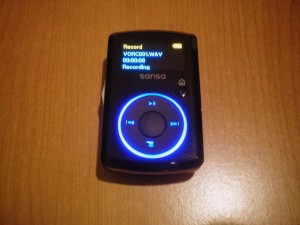Disclaimer 1: This post discusses professional applications of audio recording. Before implementing any of these, please refer to your state’s laws re: recording other parties.
Disclaimer 2: As with all my product review posts, I have no formal connection to the manufacturer. I have not received a request to write this post, nor have I received any compensation to do so from anyone. My only connection to SanDisk is as a very satisfied customer and user of this product.
The Sansa Clip is a tiny digital music player that (as you might guess) includes a clip for attaching to belts, clothes, etc. It’s similar in proportions to the 2nd-gen iPod shuffle, which means it’s comparable in size to a quarter (official measurements are 55 x 34.3 x 16.5mm, from here), and it is currently available in 1GB, 2GB, 4GB, and 8GB capacities. I originally bought my Clip to listen to music and podcasts as I ran; however, after I became a school psychologist, I found uses for it on the job.
I compare the Clip to the iPod Shuffle, but to me, the Clip provides superior value for the money (I paid around $30 for my 1GB Clip a few years ago; NewEgg currently has refurbed models for $14.99). Aside from the price (Clips cost nearly half the price of their same-capacity Apple counterparts), the magic ingredient here is the built-in digital audio recorder. The Clip can save voice recordings as .wav files, which can then be dragged & dropped from the Clip to your computer once connected via mini-USB cable.
As anyone involved in special education knows, from time to time it becomes necessary to record IEP meetings. Rather than struggle with your school’s “vintage” audio cassette recorder and having to stop and switch tapes every so often (which interrupts the flow of what is likely an already tense meeting), use a Clip (or similar digital audio recorder) to “set it and forget it” until the end of the meeting. According to SanDisk’s site (linked above), even the 1GB model can hold several hours of voice recording. I don’t know how long your meetings last, but that’s plenty for me!
The built-in microphone is surprisingly powerful. I’ve set my Clip in the middle of a table in a decent-size conference room, and the clarity and quality of voices picked up from all over the room was excellent.
Finally, moving the finished audio file is as simple as attaching the Clip to your computer via the mini-USB cable, letting the computer identify it (Windows computers will recognize the Clip as a removable hard drive), and manually dragging it to its destination through your preferred file exploring program. If it becomes necessary to share your audio files with other team members or colleagues, it’s as simple as emailing or copying it to a flash drive for them – there’s no fear of losing (or damaging!) the only cassette copy of an important recording.
Besides recording meetings, I’ve also used my Clip to record audio notes to myself (case notes, observations, etc.), which I later archive or transcribe. I can’t stress enough what a factor the size of this thing is – it’s small enough that it fits in a shirt or pants pocket, so there’s no need to lug around an antiquated cassette player and a handful of tapes. It’s just this little 2″x1″ chunk of plastic and circuitry that weighs a single ounce and records hours upon hours of audio.
So let’s review the benefits:
- Low cost
- High value
- High recording capacity
- Powerful microphone
- Small + light = easily transportable
- No tapes required
- Digital = share copies as necessary without fear of permanent loss
- Archive everything electronically
The last one is huge for me. I don’t know about you, but I’ve got far more room on my hard drive than I do in my office, so I take every opportunity I have to digitally record or scan for my files.
I also know that a significant portion of my audience is comprised of classroom teachers. Surely this has applications for students as well: note-taking, lecture recording, and basic recording for podcasting are all possible with the Clip. Students can also listen to audiobooks on these devices – the Clip plays .mp3, .wav, & .wma audio files, as well as downloads from Audible. Combine this with the library of free public domain audiobooks available for download at AudioOwl or Librivox and your students can access an entire semester’s worth of novels, plays, and short stories from their front pocket.
Regardless of whether you use this particular tool or not, please consider the advantages and disadvantages of digital audio recording. I’ve found it to be an invaluable addition to my proverbial toolbox, and I’m interested to hear how you might (or do) use it (or, as always, why you won’t ever use it and think I shouldn’t either). 🙂
